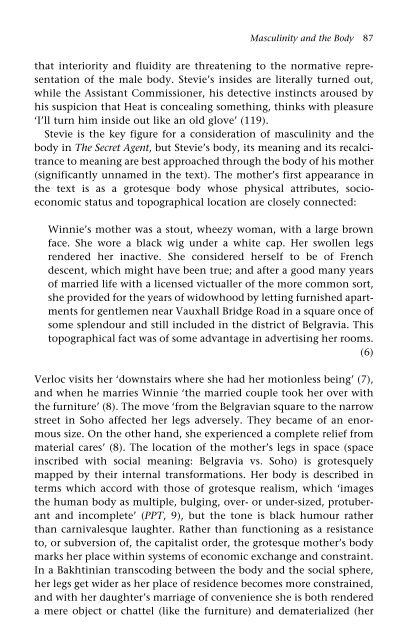Conrad and Masculinity
Conrad and Masculinity
Conrad and Masculinity
You also want an ePaper? Increase the reach of your titles
YUMPU automatically turns print PDFs into web optimized ePapers that Google loves.
<strong>Masculinity</strong> <strong>and</strong> the Body 87<br />
that interiority <strong>and</strong> fluidity are threatening to the normative representation<br />
of the male body. Stevie’s insides are literally turned out,<br />
while the Assistant Commissioner, his detective instincts aroused by<br />
his suspicion that Heat is concealing something, thinks with pleasure<br />
‘I’ll turn him inside out like an old glove’ (119).<br />
Stevie is the key figure for a consideration of masculinity <strong>and</strong> the<br />
body in The Secret Agent, but Stevie’s body, its meaning <strong>and</strong> its recalcitrance<br />
to meaning are best approached through the body of his mother<br />
(significantly unnamed in the text). The mother’s first appearance in<br />
the text is as a grotesque body whose physical attributes, socioeconomic<br />
status <strong>and</strong> topographical location are closely connected:<br />
Winnie’s mother was a stout, wheezy woman, with a large brown<br />
face. She wore a black wig under a white cap. Her swollen legs<br />
rendered her inactive. She considered herself to be of French<br />
descent, which might have been true; <strong>and</strong> after a good many years<br />
of married life with a licensed victualler of the more common sort,<br />
she provided for the years of widowhood by letting furnished apartments<br />
for gentlemen near Vauxhall Bridge Road in a square once of<br />
some splendour <strong>and</strong> still included in the district of Belgravia. This<br />
topographical fact was of some advantage in advertising her rooms.<br />
(6)<br />
Verloc visits her ‘downstairs where she had her motionless being’ (7),<br />
<strong>and</strong> when he marries Winnie ‘the married couple took her over with<br />
the furniture’ (8). The move ‘from the Belgravian square to the narrow<br />
street in Soho affected her legs adversely. They became of an enormous<br />
size. On the other h<strong>and</strong>, she experienced a complete relief from<br />
material cares’ (8). The location of the mother’s legs in space (space<br />
inscribed with social meaning: Belgravia vs. Soho) is grotesquely<br />
mapped by their internal transformations. Her body is described in<br />
terms which accord with those of grotesque realism, which ‘images<br />
the human body as multiple, bulging, over- or under-sized, protuberant<br />
<strong>and</strong> incomplete’ (PPT, 9), but the tone is black humour rather<br />
than carnivalesque laughter. Rather than functioning as a resistance<br />
to, or subversion of, the capitalist order, the grotesque mother’s body<br />
marks her place within systems of economic exchange <strong>and</strong> constraint.<br />
In a Bakhtinian transcoding between the body <strong>and</strong> the social sphere,<br />
her legs get wider as her place of residence becomes more constrained,<br />
<strong>and</strong> with her daughter’s marriage of convenience she is both rendered<br />
a mere object or chattel (like the furniture) <strong>and</strong> dematerialized (her




